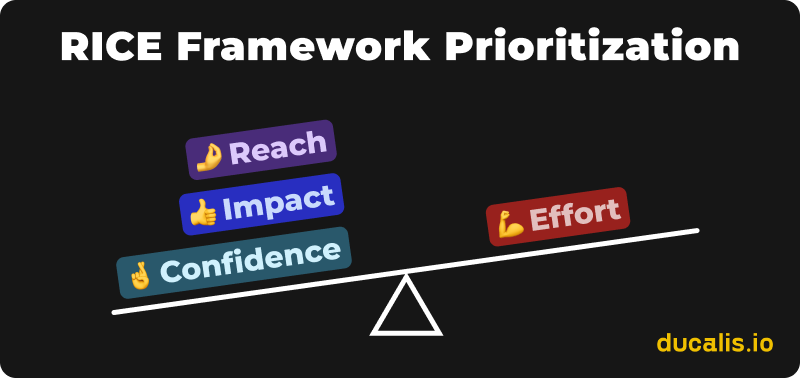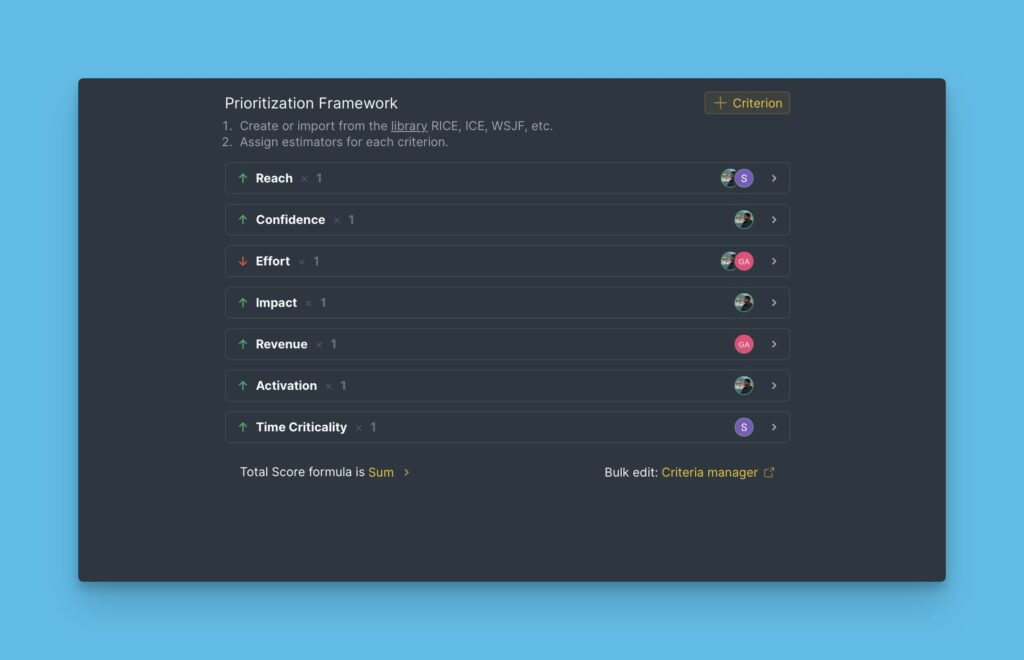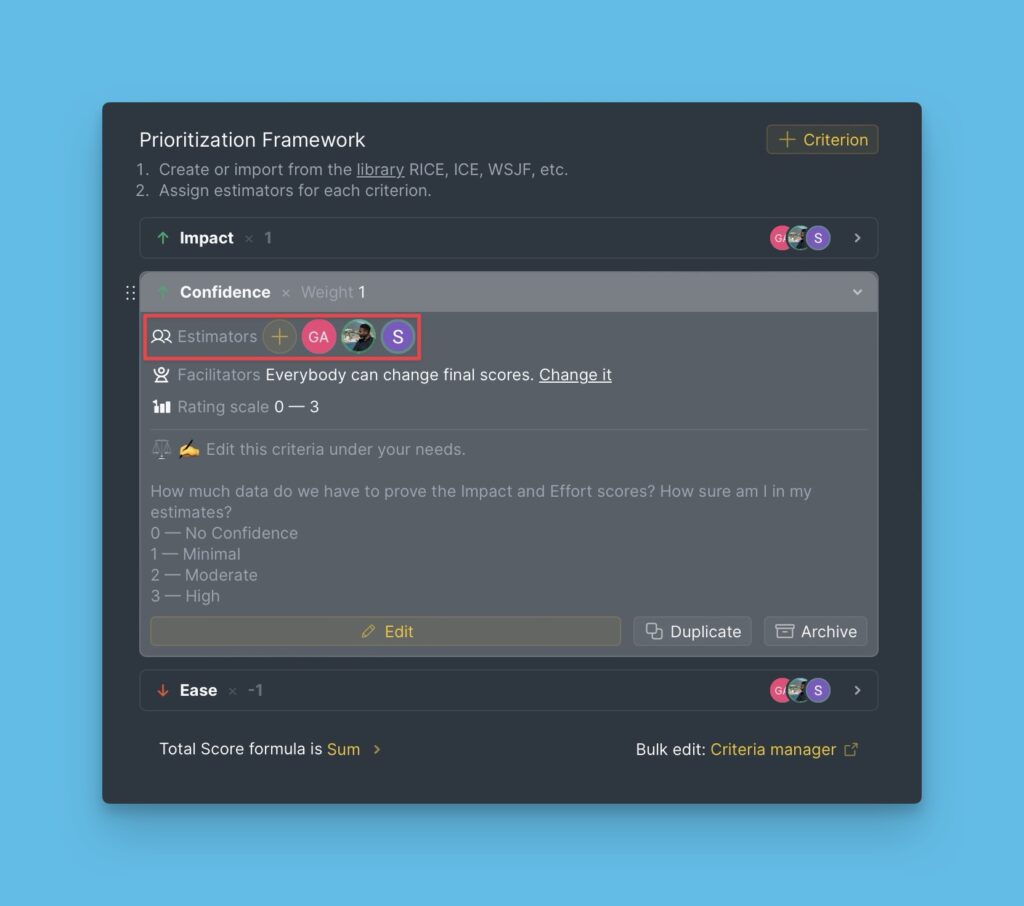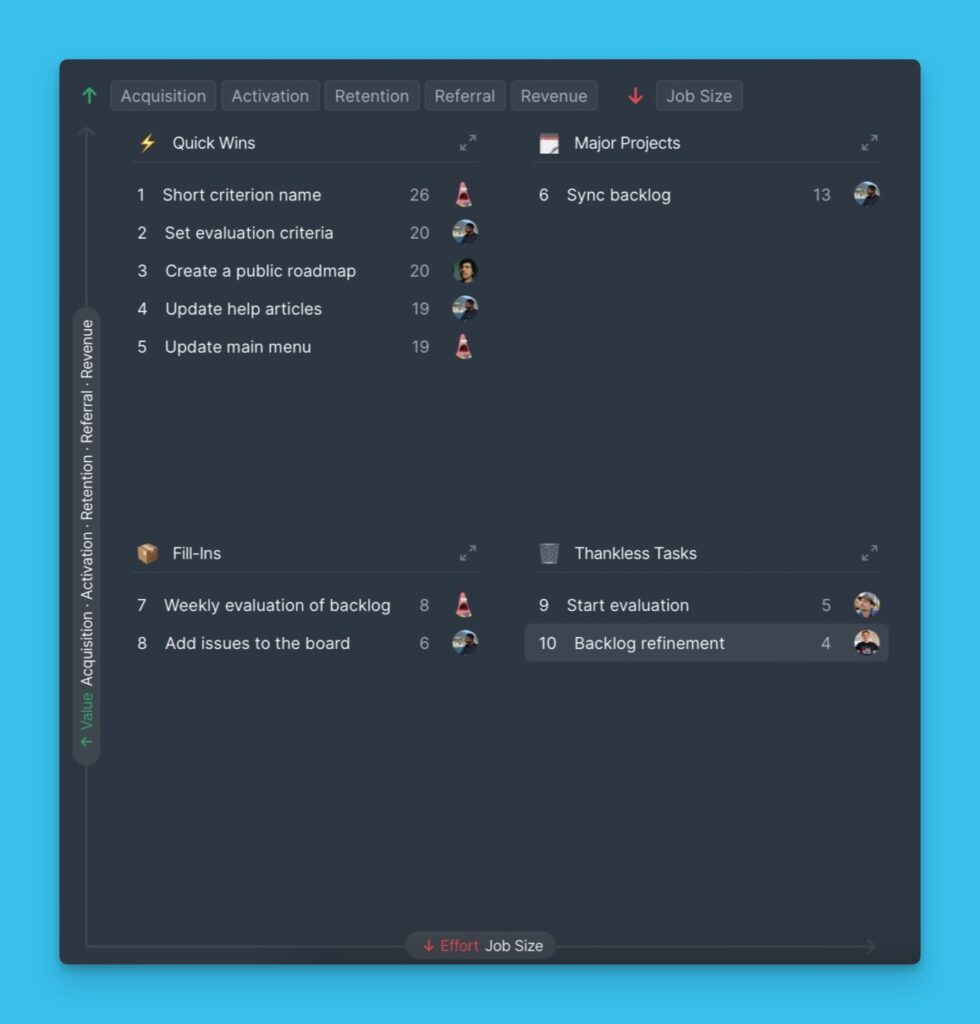
Learn to use the RICE Framework formula to prioritize your projects, calculate the score, and thoroughly understand its meaning.
What is a RICE Score
RICE Framework is a scoring model used to prioritize projects, features, and hypotheses. The abbreviation stands for Reach, Impact, Confidence, and Effort—the four factors estimated to find the most valuable solution.
Try the template with a Free Ducalis account: [SignUp]
Download the RICE template: [Try it for FREE]
How is the RICE Score Calculated
To calculate the RICE score you need to multiply the Reach, Impact, and Confidence estimates, and then divide the product by the Effort estimate.

When the calculations are ready, sort the projects by their total score in descending order—the bigger the score is, the more value you will get per time worked. Thus, you can focus on significant tasks, understanding whom you will impact, why, how, and how soon.
🤌 Reach
How many people will this feature affect within a defined period?
Estimate the number of people/events per period with any positive number.
Reach ranks your ideas by the number of leads and users it will affect. If it’s a registration page, it will touch upon every potential customer. If it’s an in-depth tweaking, only loyal users will probably notice that.
👍 Impact
How much will this feature impact the objective when a customer encounters it?
Estimate with 0.25, 0.5, 1, 2, 3, where 0.25 = Minimal; 0.5 = Low; 1 = Medium; 2 = High; 3 = Massive.
Impact ranks your ideas by the amount of influence on the objective. You should identify one goal to aim for. If you score Impact like “Idea A increases conversion rate by 2,” “Idea B increases adoption by 3,” and “Idea C maximizes delight by 2,” then such scores barely make any sense.
🤞 Confidence
How confident are you in your reach and impact estimates?
Estimate with 20%, 50%, 80%, 100%, where 20% = Moonshot; 50% = Low Confidence; 80% = Medium Confidence; 100% = High Confidence.
Confidence supports or skepticism your estimates. You are confident only when you have backup data. Confidence scores help to make the evaluation more data-driven and less emotional.
💪 Effort
How much time will the feature require from the whole team: product, design, and engineering?
Estimate with any positive number—the number of “person-months.”
Effort ranks your ideas by the amount of time their implementation requires. It completes the prioritization with the Value/Effort balance and helps to surface the Quick Wins.
[Free PDF] 🛠️ How to improve RICE with Ducalis
Download free RICE template:
8 Tips on How to Improve the RICE Framework for Better Prioritization
All the recommendations are simple and actionable. Mostly, they aren’t interdependent; you can implement a few. But by implementing all of them, you will get maximum benefits.
Now, let’s dig deeper and expand the concepts.
1. Specify the Criteria Meaning for your Product or Niche
RICE criteria descriptions that you find on the internet are general. For example, Impact—How much will the feature impact the objective? The question is, what intent!? If you leave the description as it is, you must always keep your goal in mind, which will slow down the estimation. Otherwise, your mind will wander, and after several tasks, you’ll notice that you assign high (or low) Impact scores to tasks influencing different objectives.
Most likely, you already have formulated your OKRs or a business metric to focus on to ensure growth. If so, add them to the description. Say, your main focus is customer retention, and you need to find projects that will boost the metric the most. Add it:
How much will the feature impact customer retention? Will it increase the percentage of leads falling into regular customers? Will users return to the product more often for this?
You may even rename Impact into Retention. Not to worry, nobody will judge you.

The same with Effort. It is said to be calculated with ‘person/months.’ Well, that’s definitely for some massive projects. If you’re at the rapid growth stage, it may be more beneficial to calculate your efforts in ‘person/days’ or ‘person/weeks.’ Maybe even ‘person/hours.’ Why no!? You get the idea.
→ Customizable RICE template for feature prioritization
→ Customizable RICE template for marketing prioritization
2. Add Custom Factors to Meet Your Objectives
As mentioned above, you may think of different objectives by evaluating vague Impact. And that’s only natural. We seriously doubt you have a single metric to push all the time.
Add other values for a comprehensive evaluation, such as critical business metrics like Revenue or product metrics like Activation. You may even need to add negative metrics to calculate alongside your team efforts, like Risks or additional costs like Promotion Price.
Remember, any framework is an excellent basis for a start. It doesn’t mean that prioritization will stop working if you customize the framework. It’s the other way around—it will start working better.

3. Unify the Score Scales to Prioritize Faster
RICE criteria evaluation scales are too diverse. Reach is estimated with accurate user metrics, Impact—with subjective numbers, Confidence—with percentages, and Effort—with the actual number of development days. Such scales are very inconvenient and make the evaluation slow and inconsistent.
To estimate Reach, you must first gather the data. That will steal a lot of time. And even if you manage to collect some numbers, they will still be approximate. Doesn’t it sound like a waste of time?
Prioritization is supposed to help you decide and make it fast to add velocity to your decision-making. Estimation with accurate metrics won’t make your top priorities perfect, so you don’t have to consider which project to implement.
The best solution here is to use the same score scale. Many popular sequences exist, like 0-3, 0-10, Fibonacci 1, 2, 3, 5, 8, or Exponential 1, 2, 4, 6, 8. Choose one that seems appropriate to your team and stick to it.
Estimating all the criteria with the same numbers cycle after cycle and then seeing the implemented results will help you develop an inner understanding of the scores so your estimations will become dependable.
To achieve reliability faster and lessen the subjectivity initially, add scores meaning to criteria descriptions. For example:
Reach—How many people will this feature affect within a defined time period?
1 – >100 people
2 – 100-300 people
3 – 300-600 people
5 – 600-900 people
8 – about 1K or more people
4. Collect Diverse Opinions for Expert Assessment
Estimating the backlog on one’s own has a few drawbacks.
First of all, you miss out on expert estimations. It’s unlikely that anybody else but the engineers can accurately tell how long a feature takes to ship. PMs will estimate user impact better, whereas stakeholders’ Impact on business.
Secondly, making your teammates estimate the criteria will help them to be more conscious about their tasks. A better understanding of users’ and business needs affects their day-to-day decision-making when doing the job. Those tiny decisions create the team clarity and shared experience in the end.

5. Check the Scores Scatter for Estimation Clarity
This one follows the collaborative prioritization we mentioned in the previous tip. When all the teammates have assigned their scores, looking at and comparing them is fascinating. You may find out that someone on the team:
- has a unique point of view on the project the other team members haven’t thought about
- doesn’t understand the project or the objective behind the criteria.
Sometimes even more! All the scores differ, and the team doesn’t understand the project or the criteria. Such an exercise highlights the gaps in team alignment around the goals. You need good team clarity and shared understanding if, when building a rocket, you want to get a missile, not a flying saucer.
Discuss only projects or criteria that have scattered scores to spot the problem. There’s no need to discuss the whole backlog together on the call. And this is the third bonus—you also save time on work around work.

6. Use Matrix to Visualize the Projects’ Influence
A 2×2 matrix from an extensive product backlog is handy when deciding what to develop next. It’s great to rank all the tasks on a list, but how do you know where your Quick Wins end and Major Projects begin? Distributing projects into four quadrants will immensely improve your sprint planning. The matrix will visually divide the backlog into four edible parts depending on how fast you’ll get the results and how significant they’ll be.

Estimating several positive criteria and using matrix filters can help you surface low-hanging fruit for different objectives. This is useful when you need to juggle and grow multiple metrics simultaneously. You can pick some quick wins for user Activation and Retention, ensuring they are also highly beneficial to your Revenue.

7. Discuss Priorities for Informed Decision-Making
When the whole team is informed about their OKRs, has scored their possible future projects, has resolved the disagreements, and the priorities list is ready, it’s time to decide what you all will work on next. And no, it doesn’t mean simply taking a few top projects and being good to go.
During the sprint planning meeting, review your priorities again and state which projects are best to ship. Each team member should be able to say not just, ‘I’ll do this task because it’s at the top,’ they should be able to explain—I’m implementing the X project because the results will impact the Y customers and influence the Z objective.
Understanding what the team is doing, who for, and why is the only key to making the right decisions. And thus, solid growth and development.
8. Re-evaluate projects to Update their Relevance
We once heard of a task that’s been backlogged for nine years. Nine years, Carl! Don’t want to repeat the story? Re-evaluate your backlog from time to time.
To begin, priorities change fast, sometimes overnight. A project may not reach the top initially but becomes super valuable in a few sprints. If you don’t want to lose great ideas at the bottom of your backlog, re-assess them once again over time according to new circumstances.

Such re-evaluation also helps to find trash in the backlog. If a project gets low scores cycle after cycle, that is a red flag—rethink the idea to make it more valuable or delete it for good.
Sign Up at Ducalis, connect two-way sync with your task tracker, automate your prioritization process, and create a team evaluation habit.


If for a feature the reach count is small but the overall impact due to automation is huge then how to use that effort saved as part of RICE score?